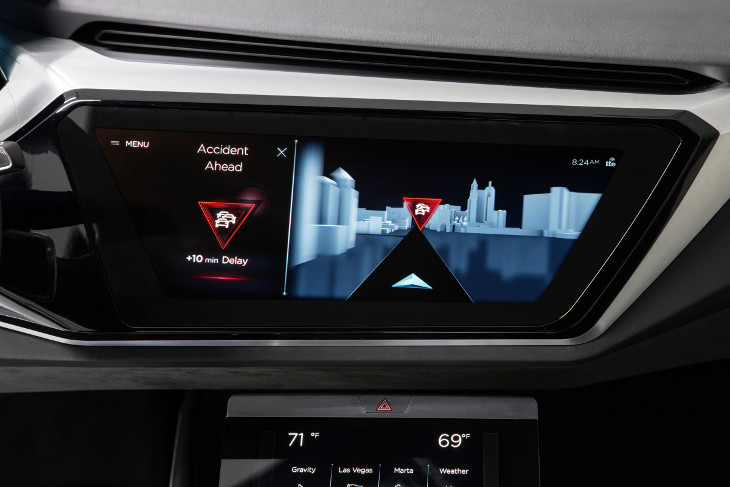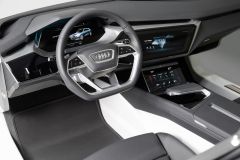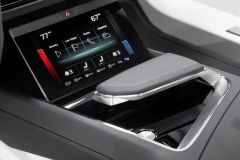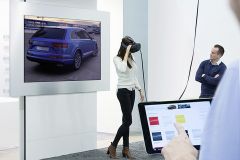
Electrification, digitalization and piloted driving: Audi is making these three future trends of the automotive industry the focus of its appearance at this year’s Consumer Electronics Show (CES). The world’s most important electronics show takes place January 6–9, 2016, in Las Vegas, Nevada.
User-friendly operation is an Audi strength, and now the brand with the four rings is expanding its operating and display concept (HMI, human-machine interface) with new solutions.
Ricky Hudi, Executive Vice President Electronic Development, commented: “The interior of the future will radically alter the way our customers operate and experience things in the vehicle. We are developing our successful Audi virtual cockpit into the Audi virtual dashboard and creating an entirely new world of experience for our customers. In the future, the entire system will get to know the customer and their habits and preferences, then proactively support them.”
The company is exhibiting an interior model at the CES demonstrating an HMI concept that features large AMOLED (active-matrix organic light-emitting diode) displays with integrated haptic feedback. The new type of MMI control with “MMI touch response” recognizes familiar touch gestures from the consumer electronics world and adapts them to the special operating environment in the automobile. Mobile devices such as smartphones and smartwatches can be seamlessly connected. Behind the new operating and display concept is the next generation of Audi’s Modular Infotainment Platform, MIB2+. Its further-enhanced computing power enables it to control several high-resolution displays. The MIB2+ is prepared for the latest wireless communication standard, LTE Advanced.
The range of online services under the Audi connect umbrella is growing quickly. The smartphone app “Audi MMI connect” offers vehicle-specific remote services. Drivers can display the location of their car on their smartphone, for example. It will also be available for fourth-generation Apple TV from 2016. Starting in 2016, the Audi connect SIM will bring Audi connect services in Europe on board with no activation procedure and enable automatic EU-wide roaming.
This year Audi is expanding its connect portfolio to include the first Car-to-X services. The new services “traffic sign information” and “hazard information” (for Europe) make the brand’s new models part of a swarm. The service “traffic light information online” (for the USA) connects the car via the mobile phone network to the central traffic computer that controls the traffic lights in the city.

The Audi e-tron quattro concept study, a fully-electric sport SUV, is on display at the CES to illustrate Audi’s electrification strategy. Three electric motors with total output of up to 370 kW enable quattro drive and electric torque vectoring, in which power is distributed to the rear wheels as necessary. The result: maximum dynamics and stability. The 95 kWh battery allows for a range of up to 500 kilometers (310.7 mi). The technology study hints at a future production model to be launched in 2018.
The Audi e-tron quattro concept includes all piloted driving functions, including piloted driving in traffic jams and piloted parking. These services represent safety, time-savings, efficiency and convenience, particularly in situations in which the driver is either overwhelmed or under-challenged. When it comes to piloted driving, Audi has been doing pioneering work in the automotive industry for many years. The core component of future systems will be the central driver assistance controller, known as the zFAS. The information supplied by all sensors – including the signals from the 3D cameras, the laser scanner and the radar and ultrasonic sensors – is permanently fed into and processed by this compact module. Thanks to its enormous computing power the zFAS will be capable of continuously comparing the data from the vehicle sensor systems with the model of the road space and its surroundings.
Specifically in this area, Audi will be able to draw on the highly up-to-date cloud data in the HERE database. AUDI AG, the BMW Group and Daimler AG acquired HERE in December 2015. In future, self-driving vehicles will need a new data basis for the navigation map that is precise to the centimeter. By drawing on the live data from HERE, the vehicle will know what to expect along its route. That is the basis it needs to evaluate any changes and movements, as well as identify potential hazards, as rapidly as possible.
Other technology fields on display at the CES underscore just how large a lead Audi has in automotive electronics. For example, the brand is presenting its lighting innovations, including the latest highlights of Matrix OLED technology and Matrix laser technology.
Audi is also moving into the field of health management: It has a vision of drivers who step out of their cars at their destinations more relaxed than when they stepped into them. Over the mid-term, Audi Fit Driver will become a supportive driving companion under the motto “My Audi cares for me.”
Another spectacular development is the Audi VR experience – at the car dealership, a sales advisor can configure any Audi model in the device so that customers can virtually experience their dream car wearing a VR (Virtual Reality) headset – with unique authenticity and all details. Audi thus becomes the first automobile manufacturer to introduce a highly advanced VR system in 2016.
Audi e-tron quattro concept CES 2016
Source: Audi





